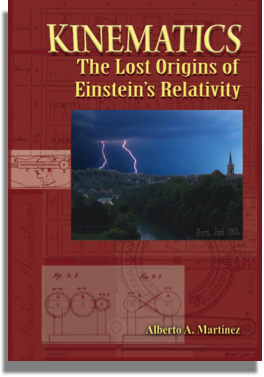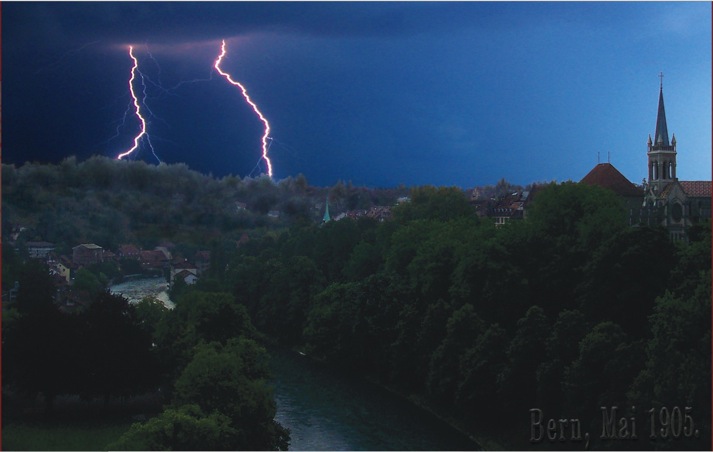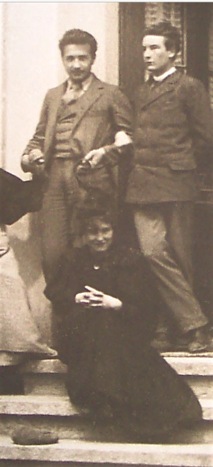



















Boston College


Academic Praise:
“...on the basis of this often-new material, Martínez has woven a fascinating new account of the development of Einstein’s theory. I believe his account supersedes the earlier accounts and sets a standard against which all future accounts will have to be measured. ... It combines broad scope and meticulous attention to detail, all recounted in a lively fashion. Reading it is not only instructive— it is a pleasure."
—John Stachel, Center for Einstein Studies, BU
author of Einstein’s Miraculous Year
The Collected Papers of Albert Einstein, founding ed.
"Martínez can certainly take credit for having produced by far the best and most detailed account of this important strand in Einstein's early work.”
—Jürgen Renn, Max Planck Institute
author of The Genesis of General Relativity
and Albert Einstein: Engineer of the Universe
"Martínez's careful reconstruction of Einstein's path to relativity is an absolute tour de force!"
—Scott Walter, Poincaré Archives
editor of La Correspondance entre
Henri Poincaré et les Physiciens
"I have no doubts that chapters 6 and 7 of Kinematics will become the definitive account of Einstein's ‘invention’ of special relativity. ... I know of no finer biographical account of the young Einstein than Martínez's."
—S. S. Schweber, Brandeis University
author of QED and the Men who Made It
and, Einstein and Oppenheimer
"This is a very impressive, original, and important piece of scholarship, one that makes a significant contribution to our understanding of physics as it was practiced in the decades leading up to Einstein. ... I am hugely impressed by what Martínez has achieved."
—Don Howard, Notre Dame
editor of Einstein: The Formative Years, 1879-1909
and Revisiting the Foundations of Relativistic Physics
"Ranging broadly over centuries of abstruse sources, across several different languages, Martínez has unearthed deep-seated discord over such questions as how to use various mathematical tools, concepts, and notations to describe the physical world. ... The payoff is significant. Martínez offers nothing less than a major revision of Einstein's route to special relativity. Make no mistake, historians and philosophers have written thousands of pages on Einstein's invention of relativity. ... This is no armchair reconstruction. Rather, Martínez has inspected and critically evaluated virtually every shred of documentary evidence..."
—David Kaiser, M.I.T.
author of Drawing Theories Apart:
The Dispersion of Feynman Diagrams
"It is amazing that such a fundamental topic, the nub of the matter really, in the history of special relativity had not been thoroughly covered."
—Alan Macdonald, Luther College
author of Linear and Geometric Algebra, and “World’s Fastest Derivation of the Lorentz Transformations”
"The chapters on Einstein form a compelling narrative as the author mines a rich vein of letters and later reminiscences, which make the book very accessible and of interest to many readers."
—Daniel Kennefick, Einstein Papers, Caltech
author of Traveling at the Speed of Thought:
Einstein and the Quest for Gravitational Waves






available at:








Early on a May morning in 1905, in Bern, Switzerland, Albert Einstein woke up with a breakthrough idea: events that are simultaneous to one observer might not be simultaneous to another. He analyzed this notion by asking himself: how would we know whether lightning bolts strike distant places at the same time? This question led him to the relativity of time. The book cover illustrates that imaginary view: it shows an early morning view of the Swiss capital with two lightning bolts striking at once.
Credit: Image based on a photograph of twin lightning by Corinne Roffler.

Book Reviews:
“ fascinating ... Recommended.”
“ #2 Best Seller in Mathematics.”
“The author uses clear and easy-to-understand language to describe how kinematics is essential to the modern study of physics.”
“A great deal of interesting historical material on kinematic ideas ... the story of Einstein’s pathway to discovery is a gem, ... an illuminating pleasure to read. Einstein, the smasher of earlier images of physics, would have been the first to applaud this very human account of himself and this period of his life. Perhaps this text will turn out to be inspirational reading for some future young Einstein! ”
“The book is really two books in one ...
Martínez deserves our gratitude for digging up a rich selection of recollections...”
“This often-overlooked branch of mechanics, which describes objects’ motion, provided the foundation for special relativity..."
“Martinez draws from an unparalleled wealth of sources...”
includes “a well-sourced biographical account of Einstein’s thinking on kinematics, culminating with his paper on the special theory of relativity. There is much on what material Einstein read, the ensuing discussions he had with his friends and colleagues, and his struggles... There is a detailed analysis of the algebra used by Einstein to explain his special theory."
“the author has indeed succeeded in offering the reader a wealth of material, published in an accessible way."
“A notable book,... history of science with substantial material dedicated to mathematics."
“This book gives the first historical account of the role that kinematics played in Einstein’s thinking about relativity."
“You don’t have to be an Einstein to learn more about Albert Einstein’s theory of special relativity, thanks to Alberto Martínez’s accessible writing style... "



Below: artwork from the back of the book jacket. The mosaic depicts the western clock-face of the Zytglogge clock tower that stands on the street where Einstein lived when he conceived the relativity of simultaneity in 1905. Around the clock is Viktor Surbek’s 1929 “Beginning of Time,” a fresco showing a figure flying with cape and scythe and an angel with a sword, as Adam and Eve retreat from Paradise. To the right, a cable car from the 1890s, above Ampère’s eyes, near the faint date 1834, when he published his notion of kinematics.







Some reviewers have been strangely
critical of Kinematics, so here I respond
to each of their specific comments.

